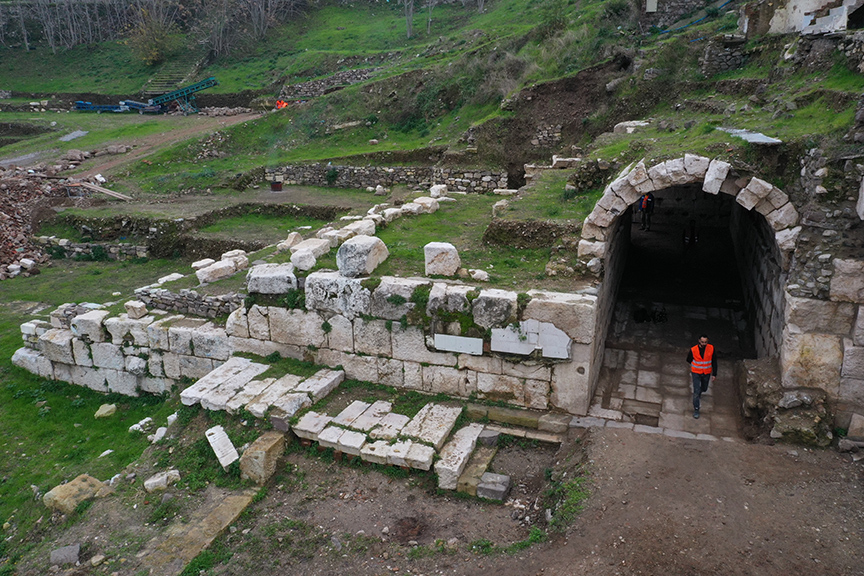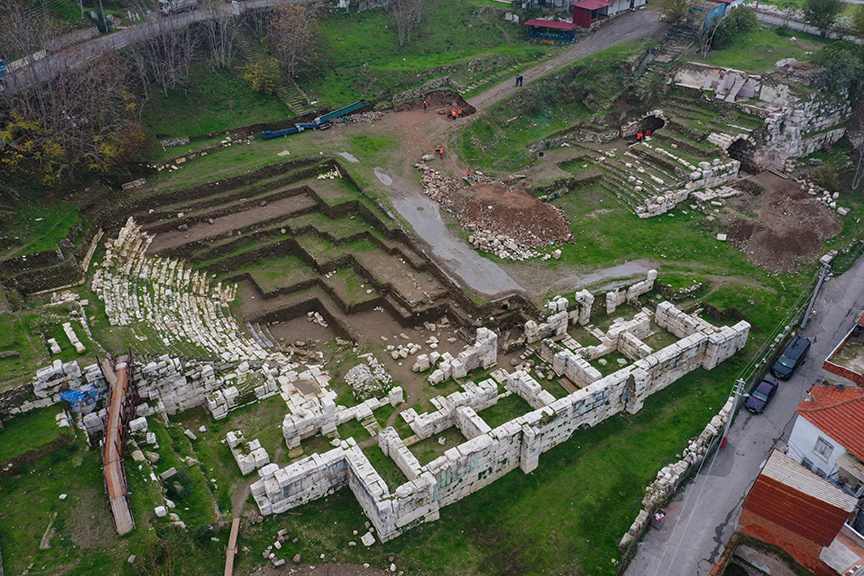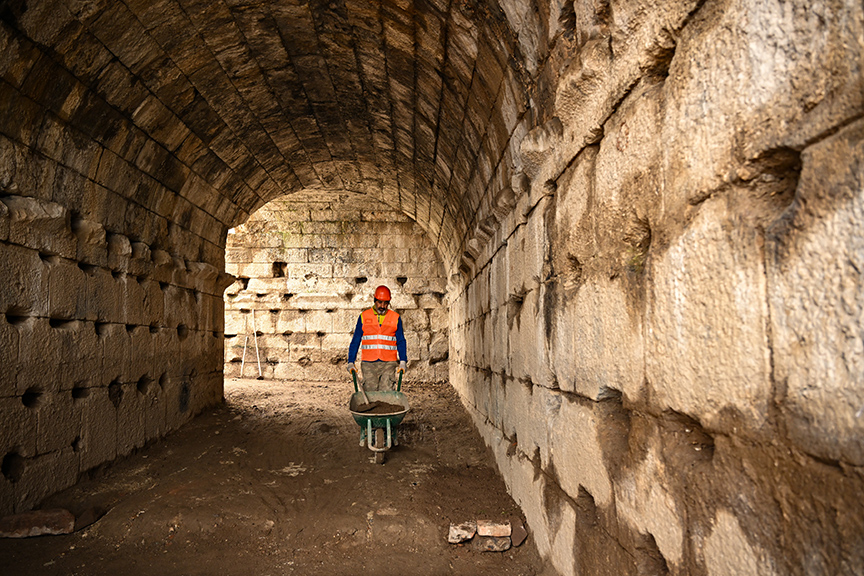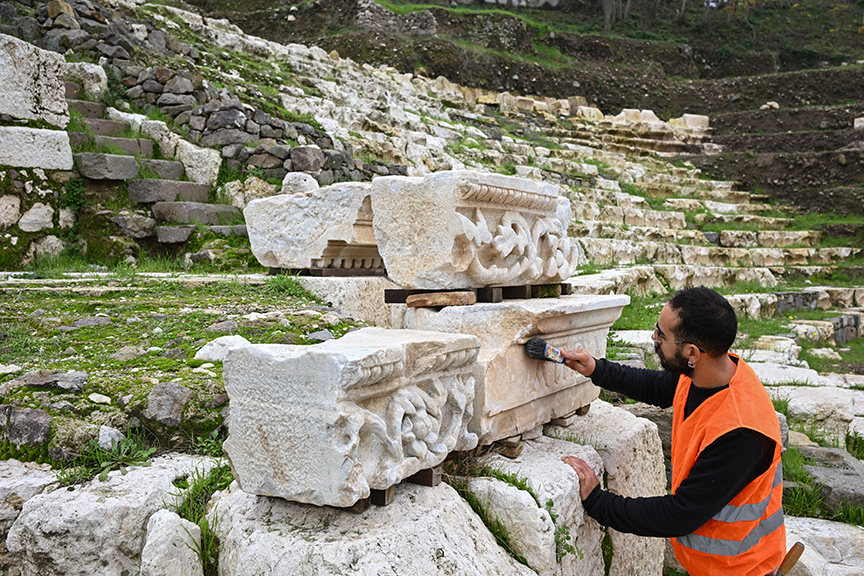
The vomitorium of the Smyrna Theater is being uncovered
In the ancient city of Smyrna, located in the center of Izmir province in Turkey, one of the two vomitoriums of a theater estimated to have a capacity of about 20,000 spectators is being uncovered.
A vomitorium is a passageway beneath or behind a row of seats in an amphitheater or stadium, allowing large crowds to exit quickly at the end of an event. It can also be used for actors to enter and exit the stage.
The theater in Smyrna is mentioned in the work “” by the Roman architect and engineer Vitruvius, who lived in the 1st century BCE.

Two years ago, the “L” shaped Vomitorium, 3 meters 66 centimeters wide and 6 meters long, was discovered in the western part of the theatre. Stating that the Vomitorium in the east direction was unearthed this year, the head of the excavation, Izmir Katip Çelebi University (İKÇÜ) Turkish Islamic Archeology Department Faculty Member Assoc. Dr. Akın Ersoy said, “Once the passage is revealed, the integrity of the theater will be restored.”
📣 Our WhatsApp channel is now LIVE! Stay up-to-date with the latest news and updates, just click here to follow us on WhatsApp and never miss a thing!!
Akın Ersoy, stating that the ancient Smyrna Theater was initially constructed with wooden framework in the 3rd century BCE, mentioned that it was transformed into a stone structure in the 2nd century BCE. Ersoy also conveyed that during the Roman Empire period, the theater was reconstructed as a stone structure again, capable of accommodating approximately 20,000 people.

Ersoy explained that this passageway served both the entrance and exit of the audience to and from the theater. It also functioned as a foundational element supporting the mid-level seating rows. He noted its dual purpose, as in the western part of the structure, where there wasn’t a natural rock foundation, they constructed this subterranean passage with arched, vaulted ceilings. This design allowed for the placement of seating tiers above. It appears they aimed to prevent the theater from leaning towards the west during earthquakes by implementing this method.
Ersoy highlighted that the design of the passageway floor was structured with steps and landing areas between each step. He indicated that this design, with landing spaces, was likely intended to prevent congestion during entry and exit.

Regarding gladiator fights, considered one of the most significant events of the ancient era, Ersoy noted:
“In the Western world, in ancient European cities, many arenas were typically constructed for this purpose. In Greece, Anatolia, and further east, there weren’t specifically built structures for gladiator fights, so theaters and stadiums were utilized for this purpose. We can learn from inscriptions that the Smyrna Theater was also used for gladiator fights.”
Ersoy expressed that they evaluated the presence of water channels in the orchestra area of the Smyrna Theater, suggesting that this space could have been filled with water to stage plays depicting naval battles.

“We’ve identified traces last year and expanded on them this year regarding a water channel, indicating the likelihood of staging various war plays representing sea battles by filling the orchestra area with water. These might have involved choreographed performances resembling water ballet. All the performances demanded by the Roman world were staged at the Smyrna Theater; this theater was used for 700 years.”
You may also like
- A 1700-year-old statue of Pan unearthed during the excavations at Polyeuktos in İstanbul
- The granary was found in the ancient city of Sebaste, founded by the first Roman emperor Augustus
- Donalar Kale Kapı Rock Tomb or Donalar Rock Tomb
- Theater emerges as works continue in ancient city of Perinthos
- Urartian King Argishti’s bronze shield revealed the name of an unknown country
- The religious center of Lycia, the ancient city of Letoon
- Who were the Luwians?
- A new study brings a fresh perspective on the Anatolian origin of the Indo-European languages
- Perhaps the oldest thermal treatment center in the world, which has been in continuous use for 2000 years -Basilica Therma Roman Bath or King’s Daughter-
- The largest synagogue of the ancient world, located in the ancient city of Sardis, is being restored











Leave a Reply